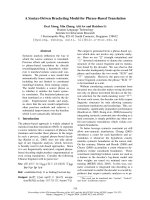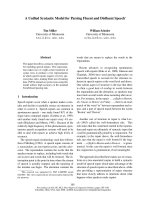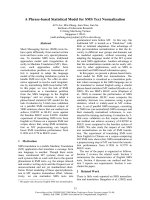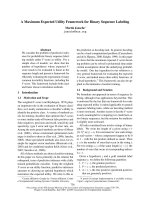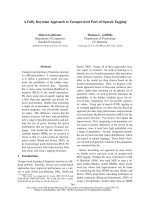Báo cáo khoa học: " A rapid and efficient method for studies of virus interaction at the host cell surface using enteroviruses and real-time PCR" potx
Bạn đang xem bản rút gọn của tài liệu. Xem và tải ngay bản đầy đủ của tài liệu tại đây (381.7 KB, 6 trang )
BioMed Central
Page 1 of 6
(page number not for citation purposes)
Virology Journal
Open Access
Methodology
A rapid and efficient method for studies of virus interaction at the
host cell surface using enteroviruses and real-time PCR
Nina Jonsson, Maria Gullberg, Stina Israelsson and A Michael Lindberg*
Address: School of Pure and Applied Natural Sciences, University of Kalmar, SE-391 82 Kalmar, Sweden
Email: Nina Jonsson - ; ; Stina Israelsson - ; A
Michael Lindberg* -
* Corresponding author
Abstract
Background: Measuring virus attachment to host cells is of great importance when trying to
identify novel receptors. The presence of a usable receptor is a major determinant of viral host
range and cell tropism. Furthermore, identification of appropriate receptors is central for the
understanding of viral pathogenesis and gives possibilities to develop antiviral drugs. Attachment is
presently measured using radiolabeled and subsequently gradient purified viruses. Traditional
methods are expensive and time-consuming and not all viruses are stable during a purification
procedure; hence there is room for improvement. Real-time PCR (RT-PCR) has become the
standard method to detect and quantify virus infections, including enteroviruses, in clinical samples.
For instance, primers directed to the highly conserved 5' untranslated region (5'UTR) of the
enterovirus genome enable detection of a wide spectrum of enteroviruses. Here, we evaluate the
capacity of the RT-PCR technology to study enterovirus host cell interactions at the cell surface
and compare this novel implementation with an established assay using radiolabeled viruses.
Results: Both purified and crude viral extracts of CVB5 generated comparable results in
attachment studies when analyzed with RT-PCR. In addition, receptor binding studies regarding
viruses with coxsackie- and adenovirus receptor (CAR) and/or decay accelerating factor (DAF)
affinity, further demonstrated the possibility to use RT-PCR to measure virus attachment to host
cells. Furthermore, the RT-PCR technology and crude viral extracts was used to study attachment
with low multiplicity of infection (0.05 × 10
-4
TCID
50
/cell) and low cell numbers (250), which implies
the range of potential implementations of the presented technique.
Conclusion: We have implemented the well-established RT-PCR technique to measure viral
attachment to host cells with high accuracy and reproducibility, at low cost and with less effort than
traditional methods. Furthermore, replacing traditional methods with RT-PCR offers the
opportunity to use crude virus containing extracts to investigate attachment, which could be
considered as a step towards viral attachment studies in a more natural state.
Background
The first critical step in the viral lifecycle involves attach-
ment and entry via interactions with one or several cell
surface receptors. The presence of a suitable receptor is the
main determinant of viral host range, cell tropism and
pathogenesis [1,2]. Enteroviruses form one genus within
the family Picornaviridae [3] and are important human
pathogens causing a wide spectrum of clinical symptoms
Published: 7 December 2009
Virology Journal 2009, 6:217 doi:10.1186/1743-422X-6-217
Received: 4 September 2009
Accepted: 7 December 2009
This article is available from: />© 2009 Jonsson et al; licensee BioMed Central Ltd.
This is an Open Access article distributed under the terms of the Creative Commons Attribution License ( />),
which permits unrestricted use, distribution, and reproduction in any medium, provided the original work is properly cited.
Virology Journal 2009, 6:217 />Page 2 of 6
(page number not for citation purposes)
including meningitis, myocarditis, gastroenteritis, polio-
myelitis, common cold and diabetes [4]. The enterovirus
genome is a positive single stranded RNA molecule of
approximately 7.500 nucleotides starting with a
5'untranslated region (5'UTR) followed by an open read-
ing frame encoding a polyprotein of about 2.200 amino
acids and a 3'UTR ending with a poly A tail [5]. Several cel-
lular receptors have been identified as attachment mole-
cules for Picornaviridae, including the poliovirus receptor
(PVR) [6], various types of integrins [7-10], intracellular
adhesion molecule 1 (ICAM-1) [11,12], decay-accelerat-
ing factor (DAF or CD55) [13,14] and coxsackie- and ade-
novirus receptor (CAR) [15,16]. Group B coxsackieviruses
(CVB) with its six serotypes, CVB1-6, may enter the sus-
ceptible cell by attachment to CAR, a 46-kDa transmem-
brane protein that also serves as a receptor for many
adenoviruses [17]. In addition, some strains of CVB1, 3
and 5 can interact with an additional receptor, DAF, a 70-
kDa regulatory protein consisting of four short consensus
repeats (SCRs) [18]. CVBs can attach to DAF, but are usu-
ally unable to enter the cell in the absence of CAR [19,20]
unless the DAF receptors are cross-linked by specific anti-
DAF monoclonal antibodies (MAbs) [21]. Thus, binding
to DAF is a characteristic feature of many enteroviruses
including enterovirus 70 and echovirus 7 [13,14,21-25].
Interactions between a virus and the host cell surface are
generally studied using purified radiolabeled virions that
are allowed to attach to cultured cells.
The real-time PCR (RT-PCR) technology utilizes the
standard PCR method with the addition of measuring the
accumulation of amplified DNA in real-time by a fluores-
cent signal. RT-PCR uses the threshold cycle (Ct) value, i.e.
the lowest number of cycles necessary to detect a fluores-
cent signal above a threshold, to quantify amplified DNA.
The recorded Ct value is directly proportional to the start-
ing number of cDNA, i. e. viral RNA, where one cycle the-
oretically represents the double amount of template. RT-
PCR is the method of choice to detect and quantify virus
infections in clinical samples, including enteroviruses
[26,27]. Amplification of highly conserved regions of the
enterovirus 5'untranslated region (5'UTR) is the golden
standard to detect enteroviruses in specimens [28,29].
In this report, we demonstrate for the first time the possi-
bility to use RT-PCR to study interactions between entero-
viruses and their target cells. RT-PCR is a rapid and
sensitive method suitable for attachment studies and
allows the use of crude virus containing extracts as well as
limited amounts of cells and viruses.
Methods
Cells and viruses
HeLa-SoH (provided by M. Rovainen, Helsinki, Finland),
CHO, CHO-CAR and CHO-DAF [30,31] cells were main-
tained in DMEM (Sigma), supplemented with 10% new-
born calf serum (NCS) (Biological Industries) and 1%
penicillin-streptomycin and L-glutamine (Sigma). 1mg/
ml G418 (Sigma) was added to CHO-CAR cells and
0.75mg/ml Hygromycin B (Invitrogen) to CHO-DAF
cells. The clinical isolate CVB5 strain 151rom70 was
kindly provided by T. Hovi (Helsinki, Finland), while
echovirus 7 strain Wallace (EV7W, ATCC VR-37) and
CVB2 strain Ohio (CVB2O, ATCC VR-29) were obtained
from American Tissue Culture Collection (ATCC). Viruses
were propagated and titrated on GMK cells.
Binding assays
CVB5 151rom70 was labeled by growth in GMK cells in
the presence of
35
S-methionine and
35
S-cysteine (Perkin-
Elmer). Virions were purified by sucrose gradient centrifu-
gation as described elsewhere [8]. Binding assays, using
both purified radiolabeled viruses and crude virus
extracts, were carried out in suspension as described by
Arnberg et al. [32]. Briefly, cells were detached with
versene solution, pelleted and washed twice in binding
buffer (DMEM supplemented with 2% NCS and 1% pen-
icillin-streptomycin and L-glutamine). Cells and viruses,
2.5 × 10
5
cells per tube if not stated otherwise, were incu-
bated for 2 h on ice or at room temperature and washed
twice with ice-cold or room temperatured binding buffer
before re-suspension in 200 μl serum-free media, all in
triplicates. For measures of radioactivity, the radiation was
determined by liquid scintillation counting, while non-
radioactive samples were frozen for further applications.
Two-step RT-PCR
RNA was extracted using QIAamp viral RNA extraction kit
(Qiagen) according to the manufacturer's instructions
and used for reverse transcription. cDNA synthesis was
performed using Applied Biosystems TaqMan reverse
transcriptase kit according to the manufacturer's protocol.
Assay conditions for quantification of extracted viral RNA
were optimized using the Applied Biosystems 7500 Real-
Time PCR System (Applied Biosystems), by using a two-
step RT-PCR and SYBR Green detection method as previ-
ously described [33]. Obtained Ct values were recalcu-
lated into RNA copies, i.e. virions, by the use of a standard
curve previously described by Jonsson et al. [33].
Statistical analyses
Individual data pairs were analysed by the unpaired t test,
and one-way analysis of variance followed by Dunnetts
post-test was used to compare groups vs. controls. Data
were considered statistically significant if p < 0.05.
Results and Discussion
Comparison of purified and unpurified viruses
Interactions between a virus and the target cell are gener-
ally studied using radioactive labeling, and subsequently
Virology Journal 2009, 6:217 />Page 3 of 6
(page number not for citation purposes)
gradient purification of viruses. The purified and labeled
viruses are allowed to interact with cultured cells and the
amount of bound radioactivity is used as a measurement
of the viral attachment capacity. In this article, we demon-
strate that RT-PCR is an alternative, rapid and efficient
method to study viral interaction with the cell surface. RT-
PCR can complement or replace the expensive and time-
consuming methods presently employed.
A clinical isolate of CVB5, CVB5 151rom70, was analysed
for validation and comparison between the standard
method with labeled viruses and the RT-PCR, with the
assumption that one enterovirus genome is equivalent to
one virion. 3 × 10
4
dpm
35
S-labeled virus (corresponding
to a multiplicity of infection (MOI) of 0.05 TCID
50
/cell)
or MOI 0.05 TCID50/cell of crude virus extracts were incu-
bated with cells in suspension on ice for 2 h. The attached
virus was measured using scintillation counting (purified,
radiolabeled virus) or RT-PCR (purified and crude virus
extracts). Using radiolabeled viruses (Figure 1A) the clini-
cal isolate of CVB5 demonstrated similar affinity for HeLa
and CHO-DAF, which could be expected due to approxi-
mately equal amount of expressed DAF on the cell sur-
faces determined by flow cytometry (data not shown).
Comparable results were recorded using RT-PCR (Figure
1B), thus supporting the applicability of RT-PCR in viral
affinity measurements. In addition, the interaction
between CVB5 151rom70 and the cell surface were stud-
ied using crude virus extracts (Figure 1C). Although the
binding of CVB5 to CHO cells was higher using crude
extracts, the specific binding to HeLa and recombinant
CHO-DAF cells were statistical significant compared to
CHO cells.
The relative binding (fold difference) of viruses attached
to HeLa in comparison to CHO was calculated for the
results presented in Figure 1. Considering the purified
virus, the RT-PCR present ~3000 fold difference (Figure
1B), while the difference in dpm is ~700 fold (Figure 1A).
Crude virus give a ~550 fold difference (Figure 1C), which
demonstrates that unpurified viruses and RT-PCR give
results that are comparable with labeled and purified
viruses, but with less effort and expense.
Altogether, these results clearly indicate the capacity of the
RT-PCR technology in studies of viral attachment. Fur-
thermore, RT-PCR gives the opportunity to study viruses
that are not purified through differential ultracentrifuga-
tion and therefore enables attachment studies using virus
in a more natural environment. Binding assays described
and discussed from this point were therefore carried out
using crude viral extracts.
The data obtained did not distinguish between binding to
CHO and CHO-CAR using the clinical isolate of CVB5,
although an indication of attachment to CHO-CAR was
observed when measuring interactions at the cell surface
using purified viruses (Figure 1A). CVB prototype strains
have been shown to utilize CAR as receptor [15,34]. Sev-
eral low-passage clinical isolates of CVB5 are less affected
by antibodies directed against CAR [23], indicating that
some CVB strains may use alternate receptors. Attachment
of crude virus extracts, analysed by RT-PCR, showed a
higher proportion of binding to CHO than labeled
viruses, which is consistent with previous reports. Martino
et al. [35] showed that several unpurified isolates of CVB
have an affinity for CHO cells. Newcombe et al. [36]
reported that unpurified coxsackievirus A20 (CVA20)
binds to RD cells, cells that do not express its major recep-
tor ICAM-1, whereas labeled and subsequently purified
CVA20 have no affinity to RD cells. Similar observations
were reported by Pash et al. [31], where two strains of
Attachment studies using a clinical isolate of CVB5Figure 1
Attachment studies using a clinical isolate of CVB5. A) 3 × 10
4
dpm (corresponding to MOI 0.05 TCID
50
/cell) was incu-
bated with 2.5 × 10
5
cells in suspension at 4°C for 2 h. Attachment was measured using scintillation counting. B) MOI 0.05
TCID
50
/cell of the labeled, purified virus and C) MOI 0.05 TCID
50
/cell of unpurified virus incubated as described in A) and the
amount of virus bound to the cell surface was measured with a two-step RT-PCR. Results are presented as mean ± SEM.
Virology Journal 2009, 6:217 />Page 4 of 6
(page number not for citation purposes)
CVB3 demonstrated no affinity for CHO cells when puri-
fied virions were used, while both strains interacted with
CHO and HeLa cells at comparable levels when crude
virus extracts were used. Hence, our observations that a
higher degree of binding to CHO cells is obtained with
crude viruses are in accordance with these previous
reports. These observations by others and us indicate that
gradient purification may alter the structure of the virion
or remove components that affect the interactions with
the cell surface. The observed differences suggest that the
interaction between virus and host cell differs in an envi-
ronment that resembles infection in its natural state in
comparison to the highly purified radiolabeled virus.
Hence the use of RT-PCR that enables to measure attach-
ment without any purification could be an advantage.
Studies regarding binding to DAF and CAR
Due to the fact that binding to DAF, but not to CAR, was
recorded using the experimental conditions described
above and RT-PCR, two additional well-characterized
enterovirus serotypes were included in the study, EV7W
and CVB2O. EV7W utilizes DAF as receptor [13,14] and
CVB2O uses CAR [15,16,34,35]. In a first set of experi-
ments, MOI 0.5 TCID
50
/cell of each virus were allowed to
attach to HeLa, CHO, CHO-CAR and CHO-DAF cells at
4°C. EV7W and CVB5 demonstrated equal binding to
HeLa and CHO-DAF, a result in accordance with previous
reports [20,37]. However, the RT-PCR analyses of CVB2O
attachment showed no statistical significant difference in
attachment between any of the cell lines at 4°C (Figure
2A). The observed lower affinity of CVB2O to susceptible
cells could be due to the fact that DAF is ten times more
abundant than CAR on HeLa cells [38], and that CVB2O
previously has been shown to have a significantly slower
attachment rate to cells than CVB5 [39]. The increase of
MOI (MOI 5 TCID
50
/cell) of CVB2O and attachment car-
ried out at 4°C or at room temperature (Figure 2B)
showed that increasing the temperature is an important
parameter using our experimental setup. Binding of
CVB2O to CHO cells was reduced at room temperature
demonstrating that incubation at a higher temperature
reduced unspecific attachment of this virus to CHO cells,
while attachment to CHO-CAR, CHO-DAF and HeLa
remained at the same level. Thus, a significant difference
in attachment to CHO-CAR and HeLa in comparison to
CHO was observed performing the measurements at
room temperature.
Interestingly, these studies indicate that CVB2O has some
affinity to CHO-DAF cells, thus suggesting that CVB2O
may have a capacity to interact with DAF at the cell sur-
face. Although, presented results give indications of an
affinity for DAF that was not affected by temperature, this
novel finding needs to be further explored. Further inves-
tigation using the RT-PCR method to quantify binding of
CVB2O and CVB4 may reveal that these viruses have some
affinity for DAF, which may explain why CVB2O could be
adapted to cytolytic replication in RD cells despite the
absence of CAR [40].
Using RT-PCR for sensitive studies of viral host cell
interactions
To explore the implementations of RT-PCR in viral bind-
ing studies the limitations in MOI and cell number that
could be used to generate recordable affinities using SYBR
green and two-step RT-PCR were investigated. A fixed
number of HeLa and CHO cells (2.5 × 10
5
) were incu-
bated with various amounts of CVB5, starting with MOI
0.05 TCID
50
/cell to a final ratio of MOI 0.05 × 10
-4
TCID
50
/cell.A significant difference in binding to HeLa in
Binding studies for DAF and CARFigure 2
Binding studies for DAF and CAR. A) MOI 0.5 TCID
50
/cell ofCVB2O, EV7W and CVB5 was incubated with 2.5 × 10
5
cells
in suspension for 2 h at 4°C and virus attachment was subsequently measured using RT-PCR. B) MOI 5 TCID
50
/cell of CVB2O
was incubated as described in A) at 4°C or at room temperature and attached virus was measured by RT-PCR. Results are
presented as mean ± SEM.
Virology Journal 2009, 6:217 />Page 5 of 6
(page number not for citation purposes)
comparison to CHO could be observed even at a MOI of
0.05 × 10
-4
TCID
50
/cell (Figure 3A). These results demon-
strate the potential to measure specific interactions with
very low amounts of viruses using this RT-PCR approach.
By using a fixed ratio of virus/host cell relation (MOI 0.05
TCID
50
/cell), the ability to study interaction using a lim-
ited amount of cells was also investigated. A decreasing
number of cells were incubated with CVB5 at a concentra-
tion of MOI 0.05 TCID
50
/cell and significant differences
in binding to HeLa in comparison with CHO cells were
observed with as few as 250 cells (Figure 3B). The data
presented above clearly demonstrate that RT-PCR is a val-
uable technology for studies of interactions between virus
and cells even when low amounts of cells or viruses are
available.
Investigating viral binding using labeled and purified
viruses is usually conducted with high virus to cell ratio,
high concentration of cells and virus in a small sample
volume [31,32,37,41]. We have demonstrated, using well-
characterized enteroviruses, that RT-PCR is a powerful
method to quantify interactions between a virus and the
cell surface. The options to use unpurified viruses, low
MOI and cell numbers indicate the opportunity to study
virus host cell interaction even when the amount of cells
and viruses are limited.
Conclusion
This article describes a straightforward, rapid and robust
method that with high accuracy can be used to quantify
viral attachment, as an alternative to traditional methods.
We present data that demonstrate the opportunity to use
crude virus extracts and RT-PCR to study binding of
viruses to cells. This is an important step towards studying
viruses in their natural state rather than using highly puri-
fied viruses for these types of studies. The potential to cir-
cumvent purification and radiolabeling of viruses gives
the possibility to study viral attachment with less effort
and at low cost. In addition, it gives the opportunity to
investigate binding of viruses that are not stable during
the purification process by differential ultracentrifugation
and viruses that can not be cultured in cell culture.
Competing interests
The authors declare that they have no competing interests.
Authors' contributions
NJ planned the experimental setup, prepared virus stocks,
carried out the binding assays, RNA extraction and real-
time PCR analysis. NJ drafted and wrote the manuscript.
MG developed the protocol for the binding assay, radiola-
beled and purified the clinical isolate and performed the
radioactive measured binding assay. SI participated in
handling and analysing recombinant cell lines. AML was
involved in the study design, draft and revision of manu-
script. All authors have read and approved the final man-
uscript.
Acknowledgements
We are grateful to Merja Rovainen and Tapani Hovi for providing cells and
virus. Britt-Inger Marklund, Sven Tågerud and Jeffrey Bergelson for help and
technical assistance. This work was supported by grants from the Swedish
Knowledge Foundation.
Sensitivity studies to measure viral attachment with RT-PCRFigure 3
Sensitivity studies to measure viral attachment with RT-PCR. A) Decreasing amount of virus, MOI 0.05-0.05 × 10
-4
TCID
50
/cell, was incubatedwith 2.5 × 10
5
cells and bound virus was analysed with RT-PCR. B) Decreasing number of CHO and
HeLa cells, 2.5 × 10
5
-2.5 × 10
2
, were incubated with MOI 0.05 TCID
50
/cell of CVB5 and attached virus was measured with RT-
PCR. Results are presented as mean ± SEM.
Virology Journal 2009, 6:217 />Page 6 of 6
(page number not for citation purposes)
References
1. Rossmann MG, He Y, Kuhn RJ: Picornavirus-receptor interac-
tions. Trends Microbiol 2002, 10:324-331.
2. Evans DJ, Almond JW: Cell receptors for picornaviruses as
determinants of cell tropism and pathogenesis. Trends Micro-
biol 1998, 6:198-202.
3. Fauquet CM, Mayo MA, Maniloff J, Desselberger U, Bell LA: Virus Tax-
onomy Elsevier Academic Press; 2005.
4. Pallanch MA, Roos RP: Enteroviruses: polioviruses, coxsackieviruses, ehco-
viruses and newer enteroviruses fourth edition. Philadelphia, PA: Lippin-
cott, Williams and Wilkins; 2001.
5. Racianello VR: Picornaviridae: The viruses and their replication 4th edi-
tion. Philadelphia: Lippincott Williams & Wilkins; 2001.
6. Mendelsohn CL, Wimmer E, Racaniello VR: Cellular receptor for
poliovirus: molecular cloning, nucleotide sequence, and
expression of a new member of the immunoglobulin super-
family. Cell 1989, 56:855-865.
7. Bergelson JM, Shepley MP, Chan BM, Hemler ME, Finberg RW: Iden-
tification of the integrin VLA-2 as a receptor for echovirus 1.
Science 1992, 255:1718-1720.
8. Bergelson JM, St John N, Kawaguchi S, Chan M, Stubdal H, Modlin J,
Finberg RW: Infection by echoviruses 1 and 8 depends on the
alpha 2 subunit of human VLA-2. J Virol 1993, 67:6847-6852.
9. Roivainen M, Piirainen L, Hovi T, Virtanen I, Riikonen T, Heino J, Hyy-
pia T: Entry of coxsackievirus A9 into host cells: specific inter-
actions with alpha v beta 3 integrin, the vitronectin receptor.
Virology 1994, 203:357-365.
10. Nelsen-Salz B, Eggers HJ, Zimmermann H: Integrin alpha(v)beta3
(vitronectin receptor) is a candidate receptor for the viru-
lent echovirus 9 strain Barty. J Gen Virol 1999, 80(Pt
9):2311-2113.
11. Greve JM, Davis G, Meyer AM, Forte CP, Yost SC, Marlor CW,
Kamarck ME, McClelland A: The major human rhinovirus recep-
tor is ICAM-1. Cell 1989, 56:839-847.
12. Staunton DE, Dustin ML, Erickson HP, Springer TA: The arrange-
ment of the immunoglobulin-like domains of ICAM-1 and
the binding sites for LFA-1 and rhinovirus.
Cell 1990,
61:243-254.
13. Bergelson JM, Chan M, Solomon KR, St John NF, Lin H, Finberg RW:
Decay-accelerating factor (CD55), a glycosylphosphatidyli-
nositol-anchored complement regulatory protein, is a recep-
tor for several echoviruses. Proc Natl Acad Sci USA 1994,
91:6245-6248.
14. Ward T, Pipkin PA, Clarkson NA, Stone DM, Minor PD, Almond JW:
Decay-accelerating factor CD55 is identified as the receptor
for echovirus 7 using CELICS, a rapid immuno-focal cloning
method. Embo J 1994, 13:5070-5074.
15. Bergelson JM, Cunningham JA, Droguett G, Kurt-Jones EA, Krithivas
A, Hong JS, Horwitz MS, Crowell RL, Finberg RW: Isolation of a
common receptor for Coxsackie B viruses and adenoviruses
2 and 5. Science 1997, 275:1320-1323.
16. Tomko RP, Xu R, Philipson L: HCAR and MCAR: the human and
mouse cellular receptors for subgroup C adenoviruses and
group B coxsackieviruses. Proc Natl Acad Sci USA 1997,
94:3352-3356.
17. Roelvink PW, Lizonova A, Lee JG, Li Y, Bergelson JM, Finberg RW,
Brough DE, Kovesdi I, Wickham TJ: The coxsackievirus-adenovi-
rus receptor protein can function as a cellular attachment
protein for adenovirus serotypes from subgroups A, C, D, E,
and F. J Virol 1998, 72:7909-7915.
18. Nicholson-Weller A: Decay accelerating factor (CD55). Curr
Top Microbiol Immunol 1992, 178:7-30.
19. Bergelson JM, Mohanty JG, Crowell RL, St John NF, Lublin DM, Fin-
berg RW: Coxsackievirus B3 adapted to growth in RD cells
binds to decay-accelerating factor (CD55). J Virol 1995,
69:1903-1916.
20. Shafren DR, Bates RC, Agrez MV, Herd RL, Burns GF, Barry RD:
Coxsackieviruses B1, B3, and B5 use decay accelerating fac-
tor as a receptor for cell attachment. J Virol 1995,
69:3873-3877.
21. Shafren DR: Viral cell entry induced by cross-linked decay-
accelerating factor. J Virol 1998, 72:9407-9412.
22. Powell RM, Schmitt V, Ward T, Goodfellow I, Evans DJ, Almond JW:
Characterization of echoviruses that bind decay accelerating
factor (CD55): evidence that some haemagglutinating
strains use more than one cellular receptor. J Gen Virol
1998,
79(Pt 7):1707-1713.
23. Bergelson JM, Modlin JF, Wieland-Alter W, Cunningham JA, Crowell
RL, Finberg RW: Clinical coxsackievirus B isolates differ from
laboratory strains in their interaction with two cell surface
receptors. J Infect Dis 1997, 175:697-700.
24. Karnauchow TM, Dawe S, Lublin DM, Dimock K: Short consensus
repeat domain 1 of decay-accelerating factor is required for
enterovirus 70 binding. J Virol 1998, 72:9380-9383.
25. Philipson L, Bengtsson S, Brishammar S, Svennerholm L, Zetterqvist
O: Purification And Chemical Analysis Of The Erythrocyte
Receptor For Hemagglutinating Enteroviruses. Virology 1964,
22:580-590.
26. Verstrepen WA, Bruynseels P, Mertens AH: Evaluation of a rapid
real-time RT-PCR assay for detection of enterovirus RNA in
cerebrospinal fluid specimens. J Clin Virol 2002, 25(Suppl
1):S39-43.
27. Verstrepen WA, Kuhn S, Kockx MM, Vyvere ME Van De, Mertens
AH: Rapid detection of enterovirus RNA in cerebrospinal
fluid specimens with a novel single-tube real-time reverse
transcription-PCR assay. J Clin Microbiol 2001, 39:4093-4096.
28. Mohamed N, Elfaitouri A, Fohlman J, Friman G, Blomberg J: A sensi-
tive and quantitative single-tube real-time reverse tran-
scriptase-PCR for detection of enteroviral RNA. J Clin Virol
2004, 30:150-156.
29. Dierssen U, Rehren F, Henke-Gendo C, Harste G, Heim A: Rapid
routine detection of enterovirus RNA in cerebrospinal fluid
by a one-step real-time RT-PCR assay. J Clin Virol 2008,
42:58-64.
30. Selinka HC, Wolde A, Pasch A, Klingel K, Schnorr JJ, Kupper JH, Lind-
berg AM, Kandolf R: Comparative analysis of two coxsackievi-
rus B3 strains: putative influence of virus-receptor
interactions on pathogenesis. J Med Virol 2002, 67:224-233.
31. Pasch A, Kupper JH, Wolde A, Kandolf R, Selinka HC: Comparative
analysis of virus-host cell interactions of haemagglutinating
and non-haemagglutinating strains of coxsackievirus B3. J
Gen Virol 1999,
80(Pt 12):3153-3158.
32. Arnberg N, Edlund K, Kidd AH, Wadell G: Adenovirus type 37
uses sialic acid as a cellular receptor. J Virol 2000, 74:42-48.
33. Jonsson N, Gullberg M, Lindberg AM: Real-time polymerase
chain reaction as a rapid and efficient alternative to estima-
tion of picornavirus titers by tissue culture infectious dose
50% or plaque forming units. Microbiol Immunol 2009,
53:149-154.
34. Hsu KH, Lonberg-Holm K, Alstein B, Crowell RL: A monoclonal
antibody specific for the cellular receptor for the group B
coxsackieviruses. J Virol 1988, 62:1647-1652.
35. Martino TA, Petric M, Weingartl H, Bergelson JM, Opavsky MA, Rich-
ardson CD, Modlin JF, Finberg RW, Kain KC, Willis N, et al.: The
coxsackie-adenovirus receptor (CAR) is used by reference
strains and clinical isolates representing all six serotypes of
coxsackievirus group B and by swine vesicular disease virus.
Virology 2000, 271:99-108.
36. Newcombe NG, Andersson P, Johansson ES, Au GG, Lindberg AM,
Barry RD, Shafren DR: Cellular receptor interactions of C-clus-
ter human group A coxsackieviruses. J Gen Virol 2003,
84:3041-3050.
37. Spiller OB, Goodfellow IG, Evans DJ, Almond JW, Morgan BP: Echo-
viruses and coxsackie B viruses that use human decay-accel-
erating factor (DAF) as a receptor do not bind the rodent
analogues of DAF. J Infect Dis 2000, 181:340-343.
38. Goodfellow IG, Evans DJ, Blom AM, Kerrigan D, Miners JS, Morgan
BP, Spiller OB: Inhibition of coxsackie B virus infection by sol-
uble forms of its receptors: binding affinities, altered particle
formation, and competition with cellular receptors. J Virol
2005, 79:12016-12024.
39. Crowell RL: Comparative generic charactericstics of picornavirus-receptor
interactions New York: Raven Press; 1976.
40. Polacek C, Ekstrom JO, Lundgren A, Lindberg AM: Cytolytic repli-
cation of coxsackievirus B2 in CAR-deficient rhabdomyosar-
coma cells. Virus Res 2005, 113:107-115.
41. Milstone AM, Petrella J, Sanchez MD, Mahmud M, Whitbeck JC,
Bergelson JM: Interaction with coxsackievirus and adenovirus
receptor, but not with decay-accelerating factor (DAF),
induces A-particle formation in a DAF-binding coxsackievi-
rus B3 isolate. J Virol 2005, 79:655-660.


